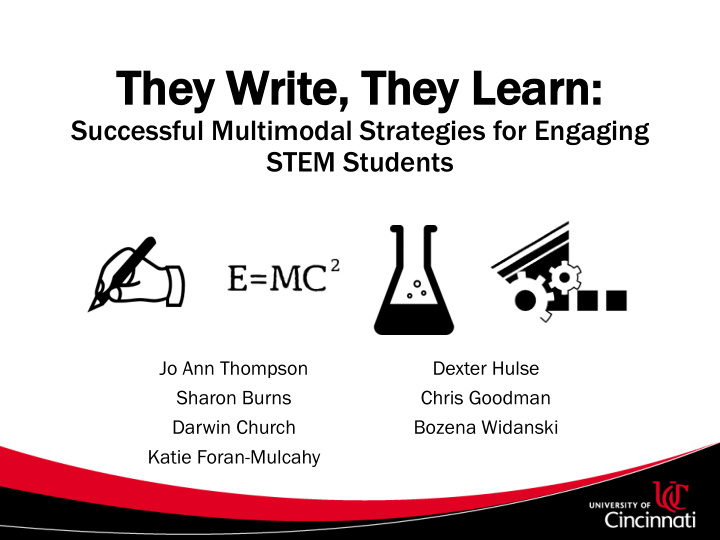



The They W y Write, The , They y Learn: Successful Multimodal Strategies for Engaging STEM Students Jo Ann Thompson Dexter Hulse Sharon Burns Chris Goodman Darwin Church Bozena Widanski Katie Foran-Mulcahy
Are you involved in multimodal writing across the curriculum projects with STEM?
Project Context and Overview Jo Ann Thompson, Associate Professor of English
Project Context at Our Institution What is is the n e need eed? - Discontent over students ’ ability to internalize content - Moving beyond a static e-document to a multimodal/interactive project What a t are w we doing about i ut it? - Writing in electronic environments = writing in the public space of the internet Who h has s been een in involved ed? - Faculty experts in science, technology, math, allied health, and the humanities
Multimodal Writing Across the Curriculum • Electronic poster • Guided lit search worksheet • CAD drawing/space rendering • Original song • Video • Online peer review • Blog • Collaborative file share
Multimodal Writing in Physics Darwin Church, Professor of Physics
Writing in Physics • Essays • Sentences • Compositions • Paragraphs Everyday language
Why do we ask students to write? Say it. Write it. Think it.
Results? • Improved use of vocabulary in written and verbal explanations • Improved conceptual understanding • Improved use of formulas
Multimodal Writing in Chemistry Bozena Widanski, Professor of Chemistry
Organic Chemistry Projects
Status Quo Outcomes
Multimodal Writing in Manufacturing Engineering Technology Chris Goodman, Assistant Professor Educator of MET
Manufacturing Engineering Technology 2-Year, A , Assoc ociate Degree • Sop ophomo more P Proj oject Co Cour urse/ • Capstone one Project: design, prototype, manufacture, document assigned project 2015 Project = Chess Sets • 2016 Project = Stirling Engines • Do Docum umentation: • Typical Documentation (2015) Technical Manual (2016)
What’s missing from these pictures?
Why collaborate with a technical writing course? • Success in manufacturing requires effective communication and writing skills • Communication throughout project AKA project management • Documentation cannot be an afterthought • Documentation needs more than technical data – communicate results not just show them
Multimodal Writing in Manufacturing Engineering Technology Dexter Hulse, Professor of MET
Pre T Tech W Writing: Everything is good or bad by comparison. Previou ious r s requir irements: ts: • A three-ring binder with all necessary docs to replicate project • One person selected/volunteered • Heavy on process (photos/CAD drawings) • Documentation at end of course • Not graded on writing/grammar
Post T Tec ech W h Writing Curre rrent nt r requi uire rement nts: • Documentation on a progressive basis • Team documentation during course • Emphasis on writing supports defined project steps • Improves critical thinking through detailed explanation of project components • Promotes audience awareness • Dual course accountability
Previous pr project cts Cu Curre rrent p projects
What’s on the horizon for WAC collaborations with STEM faculty?
Supporting Information Literacy in STEM Katie Foran-Mulcahy, Director and Associate Librarian
Ideas Tools
Six Information Literacy Frames (+ writing) in STEM • Authority is constructed and contextual • Information creation as a process • Information has value • Research as inquiry • Scholarship as conversation • Searching as strategic exploration
Librarian as technology teacher • Demo-ing Google Drive (Docs) as a collaborative writing environment • Searching the chemical/physics literature online • Creating digital posters in PowerPoint PDF • Researching stirling engines online
Supporting Writing in STEM Sharon Burns, Associate Professor of English
Writing: The power to create critical (conceptual) awareness
SIMILAR; NOT THE E SAM SAME WAC expectations among disciplinary efforts
Making connections between disciplinary foci
Does your institution provide any unique support systems for WAC efforts in STEM?
Works Cited Al-Rawahi, Nawar M., and Sulaiman M. Al-Balushi. "The Effect Of Reflective Science Journal Writing On Students' Self-Regulated Learning Strategies." International Journal Of Environmental & Science Education 10.3 (2015): 367-379. Education Research Complete. Web. 21 June 2016. Anson, Chris M. "My Dinner With Calais." Pedagogy 11.3 (2011): 578-590. Education Research Complete. Web. 21 June 2016. “Framework for Information Literacy for Higher Education.” Association of College & Research Libraries. American Library Association. 2 Feb. 2015. Web. 1 June 2016. Linkon, Sherry Lee, and Matthew Pavesich. “An Affordance Approach to WAC Development and Sustainability.” WAC Journal 26 (2015): 22-35. Web. 1 June 2016. Reynolds, Julie A., Christopher Thaiss, Wendy Katkin, and Robert Thompson, Jr. “Writing-to-Learn in Undergraduate Science Education: A Community-Based, Conceptually Driven Approach.” Science Life Education 11:1 (2012): 15-25. Web. 1 June 2016. Singh, Chandralekha. “What Every Physics Teacher Should Know About Cognitive Research.” American Association of Physics Teachers Conference Summer Meeting Workshop . AAPT: Omaha, 2011.
Recommend
More recommend